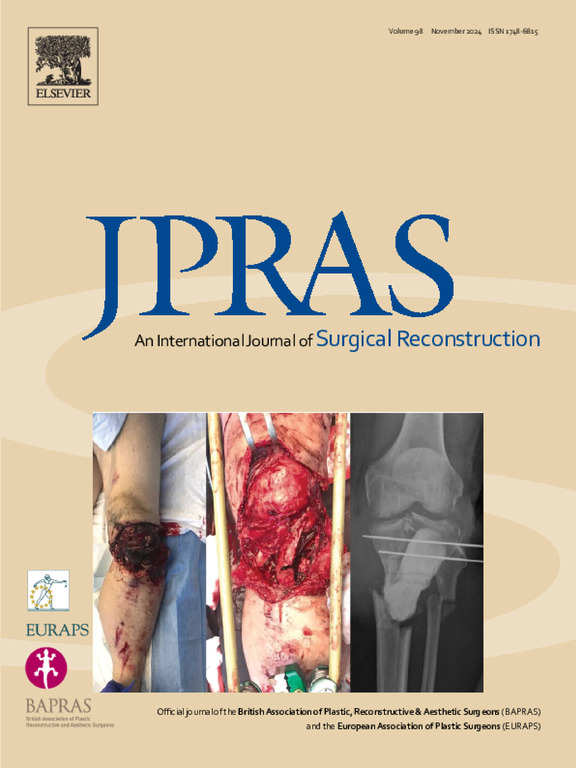CT 血管造影术中分期 CT 扫描在 DIEP 皮瓣重建规划中不断发展的作用
IF 2
3区 医学
Q2 SURGERY
Journal of Plastic Reconstructive and Aesthetic Surgery
Pub Date : 2024-09-07
DOI:10.1016/j.bjps.2024.09.009
引用次数: 0
摘要
背景在下腹穿孔器(DIEP)皮瓣重建术中,使用 CT 血管造影术(CTA)制定术前计划是一项重要的术前工具。本研究旨在描述在引入并进一步修改包括胸部、腹部、骨盆和肌肉骨骼系统在内的联合 CTA 和 CT 分期术前方案后,对偶然发现的处理情况。材料和方法对 2015 年至 2019 年期间接受 DIEP 皮瓣手术的 292 例乳腺癌患者(第 1 组)进行回顾性病例系列研究。之后在 2019 年至 2021 年期间对 101 名患者(第 2 组)进行了重新评估,并修改了分期-CT 方案,仅纳入接受化疗的患者。第一组包括即刻重建和延迟重建,而第二组只包括高风险的延迟重建病例。结果总体而言,第一组中有 30% 的患者(很可能是那些接受了延迟重建的患者)的检查结果建议进一步随访。简而言之,第2组中56.4%的患者有偶然发现,其中42.1%的患者需要重复扫描,7%的患者被转诊到其他专科,47.4%的患者不需要采取进一步行动。两个系列中均无隐匿性转移性乳腺癌病例;但在第一个系列中,仅有1%的患者被诊断为非乳腺部位的新发原发性癌症。本单位改变了做法,在2019年底前停止对低风险患者进行术前分期,将其保留给高风险患者群体,以降低成本。本文章由计算机程序翻译,如有差异,请以英文原文为准。
Evolving role of staging CT scans during CT-angiography for DIEP flap reconstruction planning
Background
Preoperative planning with CT-angiography (CTA) in deep inferior epigastric perforator (DIEP) flap reconstruction is an essential preoperative tool. The aim of this study was to describe the management of the incidental findings following the introduction and further modification of a combined CTA and CT-staging preoperative protocol which includes chest, abdomen, pelvis, and musculoskeletal system.
Material and methods
A retrospective case series of 292 patients (Group 1) with breast cancer who underwent DIEP flap between 2015 and 2019. This was followed by a re-assessment between 2019 and 2021 of 101 patients (Group 2) following modification of the staging-CT protocol to include only those patients who received chemotherapy. Group 1 included immediate and delayed reconstruction; whereas Group 2 included only the high-risk delayed reconstruction cases. Both groups had CT staging.
Result
Overall, 30% of Group 1, most likely those who had the delayed reconstruction, had findings which were recommended for further follow-up. This led to a change in staging of the high-risk patients only at the end of 2019 to those who underwent chemotherapy and had delayed reconstruction.
Briefly, 56.4% of Group 2 demonstrated incidental findings, 42.1% of them required repeat scanning, 7% were referred to other specialties, and 47.4% did not require further action. There were no cases of occult metastatic breast cancer in either series; however, 1% were diagnosed with de novo primary cancers at non breast sites only in the first series.
Conclusion
The screening of patients with asymptomatic breast cancer as part of CTA scanning prior to autologous reconstruction is not universally practiced and not supported by the NICE guidelines. This unit changed the practice to stop preoperative staging for low-risk patients by the end of 2019, and reserved it for the high-risk patient groups to reduce cost.
求助全文
通过发布文献求助,成功后即可免费获取论文全文。
去求助
来源期刊
CiteScore
3.10
自引率
11.10%
发文量
578
审稿时长
3.5 months
期刊介绍:
JPRAS An International Journal of Surgical Reconstruction is one of the world''s leading international journals, covering all the reconstructive and aesthetic aspects of plastic surgery.
The journal presents the latest surgical procedures with audit and outcome studies of new and established techniques in plastic surgery including: cleft lip and palate and other heads and neck surgery, hand surgery, lower limb trauma, burns, skin cancer, breast surgery and aesthetic surgery.

 求助内容:
求助内容: 应助结果提醒方式:
应助结果提醒方式:


